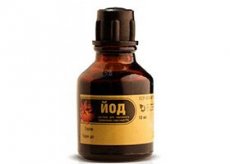Medical expert of the article
New publications
Preparations
Iodine alcohol solution 5%
Last reviewed: 03.07.2025

All iLive content is medically reviewed or fact checked to ensure as much factual accuracy as possible.
We have strict sourcing guidelines and only link to reputable media sites, academic research institutions and, whenever possible, medically peer reviewed studies. Note that the numbers in parentheses ([1], [2], etc.) are clickable links to these studies.
If you feel that any of our content is inaccurate, out-of-date, or otherwise questionable, please select it and press Ctrl + Enter.

A medicinal product for external use, has an antiseptic, irritating and distracting effect.
Ingredients of the preparation: elemental iodine – 5 g; potassium iodide – 2 g; water and 95% alcohol in equal parts up to 100 ml.
Appearance: reddish-brown liquid with a specific odor.
Indications Iodine alcohol solution 5%
The solution is used as a disinfectant in cases of skin surface injury, infection and inflammatory processes, and as a distraction in myalgia and neuralgia. Internally - in the treatment of atherosclerosis and tertiary syphilis.
Release form
- dark glass bottles of 10, 15 and 25 ml;
- 1 ml ampoules, packed in 10 ampoules.
Pharmacodynamics
Pharmacological action: antiseptic, antimicrobial, distracting. Has a wide range of bactericidal activity, eliminates all major pathogens: viruses, bacteria, fungi, protozoa. With prolonged exposure, eliminates bacterial spores, which are the most difficult form of microorganisms to disinfect, damaging the walls of their cells. It exhibits a tanning, cauterizing, irritating effect on the skin and mucous membranes. Promotes hemostatics. When absorbed, iodine affects metabolic processes in the body, promotes the production of hormone T4.
Pharmacokinetics
When in contact with skin or mucous membranes, 30% of the drug is converted into iodine salts, and the remaining portion is converted into active iodine, which is partially absorbed by organs and tissues, including the thyroid gland. The main part of the drug is excreted through the kidneys.
Dosing and administration
Disinfection of wounds and stopping of bleeding – the edges of the wound, but not the surface, are treated with a swab soaked in the preparation.
The distracting effect is achieved by applying an iodine grid to the site of localization of pain.
Use Iodine alcohol solution 5% during pregnancy
Pregnant women should use with caution, as absorption of iodine may lead to hormonal imbalance in the embryo.
Contraindications
Allergy to the drug. Do not use in case of allergic and diabetic skin lesions, furuncles, acne, hyperfunction and neoplasms of the thyroid gland, acute and chronic kidney diseases, children under 5 years of age.
Side effects Iodine alcohol solution 5%
Treatment of damaged epithelial layer of skin: rarely - allergic reaction.
Long-term use on skin of large area - possible runny nose, cough, salivation, lacrimation, rashes (iodism).
Ingestion may cause allergic reactions, increased heart rate, irritability, insomnia, hyperhidrosis, diarrhea, nausea.
Overdose
Overdose may result in iodism, irritation and burns.
Interactions with other drugs
There is a pharmaceutical incompatibility with ammonia solutions and odorous vegetable oils.
The reaction with mercury amidochloride occurs with the formation of an explosive compound.
The disinfecting effect weakens the interaction with physiological fluids, organic compounds, alkalis, acids.
Slows down the decrease in the hormone T4 in the case of taking drugs for the treatment of hyperthyroidism.
Storage conditions
In a dark, cool place, out of reach of children.
Shelf life
Store for 3 years.
Attention!
To simplify the perception of information, this instruction for use of the drug "Iodine alcohol solution 5%" translated and presented in a special form on the basis of the official instructions for medical use of the drug. Before use read the annotation that came directly to medicines.
Description provided for informational purposes and is not a guide to self-healing. The need for this drug, the purpose of the treatment regimen, methods and dose of the drug is determined solely by the attending physician. Self-medication is dangerous for your health.

